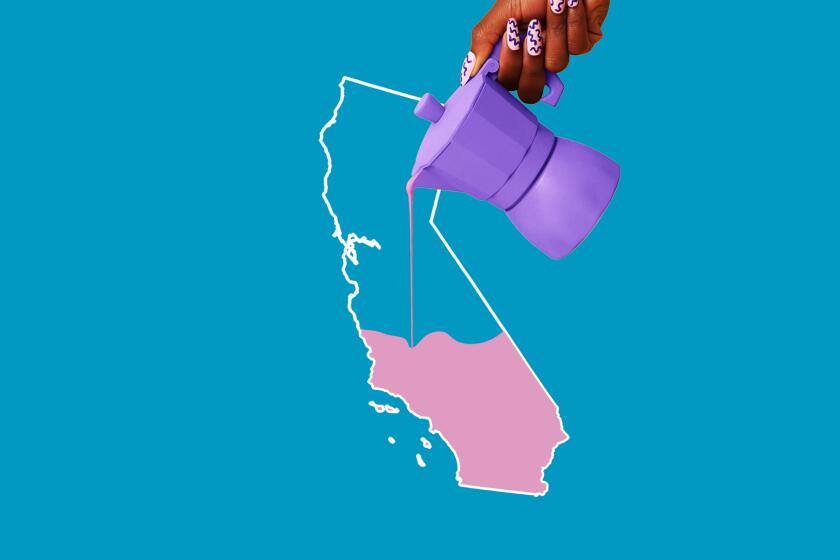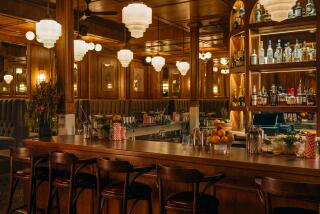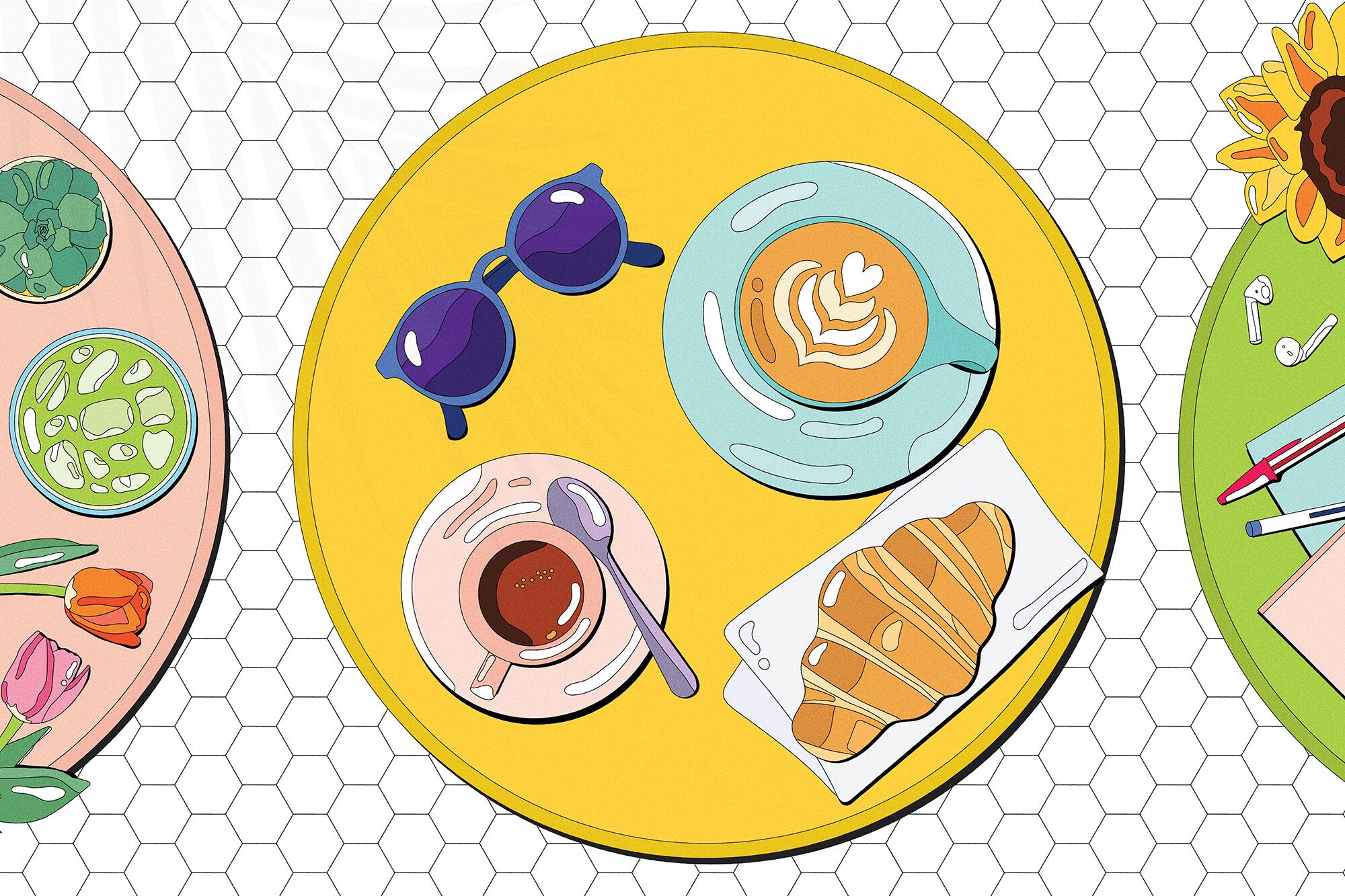
On an overcast day in late April, more than 50 people — mostly the young and cool, wearing obscure streetwear brands, bucket hats and designer sneakers — stood in line in a parking lot in West Adams. They hunched over a small, contact-free window, modeled after the wine windows used during the bubonic plague, and placed their orders.
This was No Free Coffee’s Tiny Cafe pop-up — “a punk rock response to coffee,” says Mario Kristian, a creative producer who has been hosting the coffee pop-ups since October. You have to be in the know to know what to cop. No Free Coffee serves specialty drinks like the Grapefruit Tootsie (Ethiopian natural sun-dried cold brew with Italian pink grapefruit soda) and slings apparel (trucker hats, basketball shorts, hoodies, sweatpants, mugs and more). The bio on No Free Coffee’s Instagram says it all: “We do coffee, but the clothes really hit.”
California is reopening, but when it comes to coffee shops, will anyone ever feel comfortable ordering their drink to stay and lingering for a while in the presence of others?
No Free Coffee’s Tiny Cafe might be a loose vision of what coffee shops will start to look like post-pandemic — in spirit, at least. With shops across the city reopening for dine-in service, L.A. customers are craving more than just a jolt of caffeine. They want community. They want merch. They want to engage with others. They want inclusivity. After the hellscape that was 2020, they want more life.
They want, in other words, what L.A. coffee shops gave them before. Pre-pandemic, coffee shops were our offices and our living rooms. They were the club and the place we came back to life the morning after raging at the actual club. In a big and sometimes lonely city, coffee shops were our points of connection and our anchors.
But when COVID hit, they became just what their name implies: a place to get coffee and go. “The pandemic turned it into a transactional event rather than the usual relational one — people come, grab and leave,” says Geoffrey Martinez, owner of Patria, a coffee roaster and shop in Compton.
What was lost?
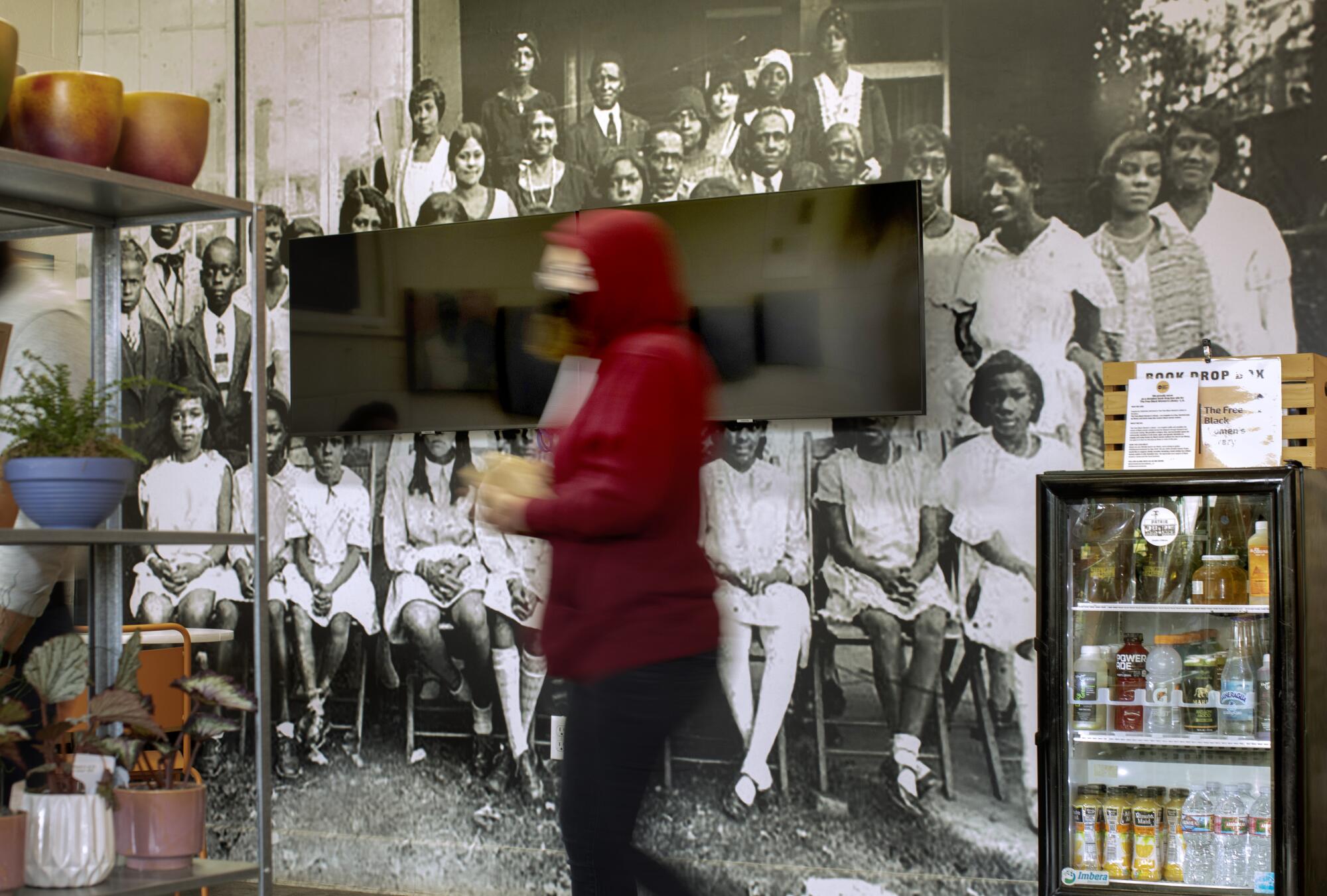
Opened in 2018, the third-wave coffee shop was the kind of place where creative people collaborated on projects and students from nearby Cal State Dominguez Hills or Compton College might run into their professor on a lunch break. Kahlil Joseph’s conceptual news broadcast, “BLKNWS,” streams on double monitors hanging on the east wall, while an exhibition from a local photographer hangs on the north.
Yoshawn Smith, Patria’s barista and manager, remembers the shop as a “a culture club of really great things and a second home for people. The library outside the library. The study place outside the university,” he says. Some of his most loyal customers were video editors, musicians, comic book writers, illustrators, graphic designers, architects, activists, environmentalists and woodworkers. “It was crazy,” he remembers.
Last year, Patria saw a spike in customers because of the push to support Black-owned businesses over the summer, but it lost its ability to be a warm space of culture and community. The open mikes, the events and, most notably, the communal table were shuttered.
Sitting in the minimal space today, with your mask pulled to your chin as you sip from a matcha latte, it’s hard to ignore the ways the pandemic has altered the coffee shop of yesterday. Sure, there’s the familiar, comforting woosh of the espresso machine; there is a stream of people to watch from its street-facing window. But something about the nature of people rushing in and out to pick up to-go orders reminds you how much things have changed.
Adaeze Oduma, who lives near the Compton/Woodley Airport, has been coming to Patria since summer, but she only recently has been able to sit down at a table with a friend.
“I missed that,” Oduma says. “Just being able to have conversations face to face. I’m hoping that later in the future I can actually come in and sit down here without a mask.”
For Oduma, coffee shops have always served as a romanticized symbol of chance, a place where anything can happen. “Just like the movies and the books, like the meet-cutes.”
As coffee shop culture revs up again, she is eager to reconnect with people from her neighborhood.
“It’s really a space that I think reflects the community,” Oduma says.
Aron Sanchez is the kind of person who can list five of the best cafes from five neighborhoods by memory. Before 2020, Sanchez saw potential in coffee shops. At their best, they were spaces where people who might share an identity could find community. “In queer culture, a lot of folks go to a cafe to relax and read together or whatever,” Sanchez says. “And if you go there often enough, it feels like a touch of home.
“This is a bunch of meaning to put into a cafe,” Sanchez adds, “but if the owners put enough work into it, it can really be like a safe haven for different kinds of people.”
Craving more than just a jolt
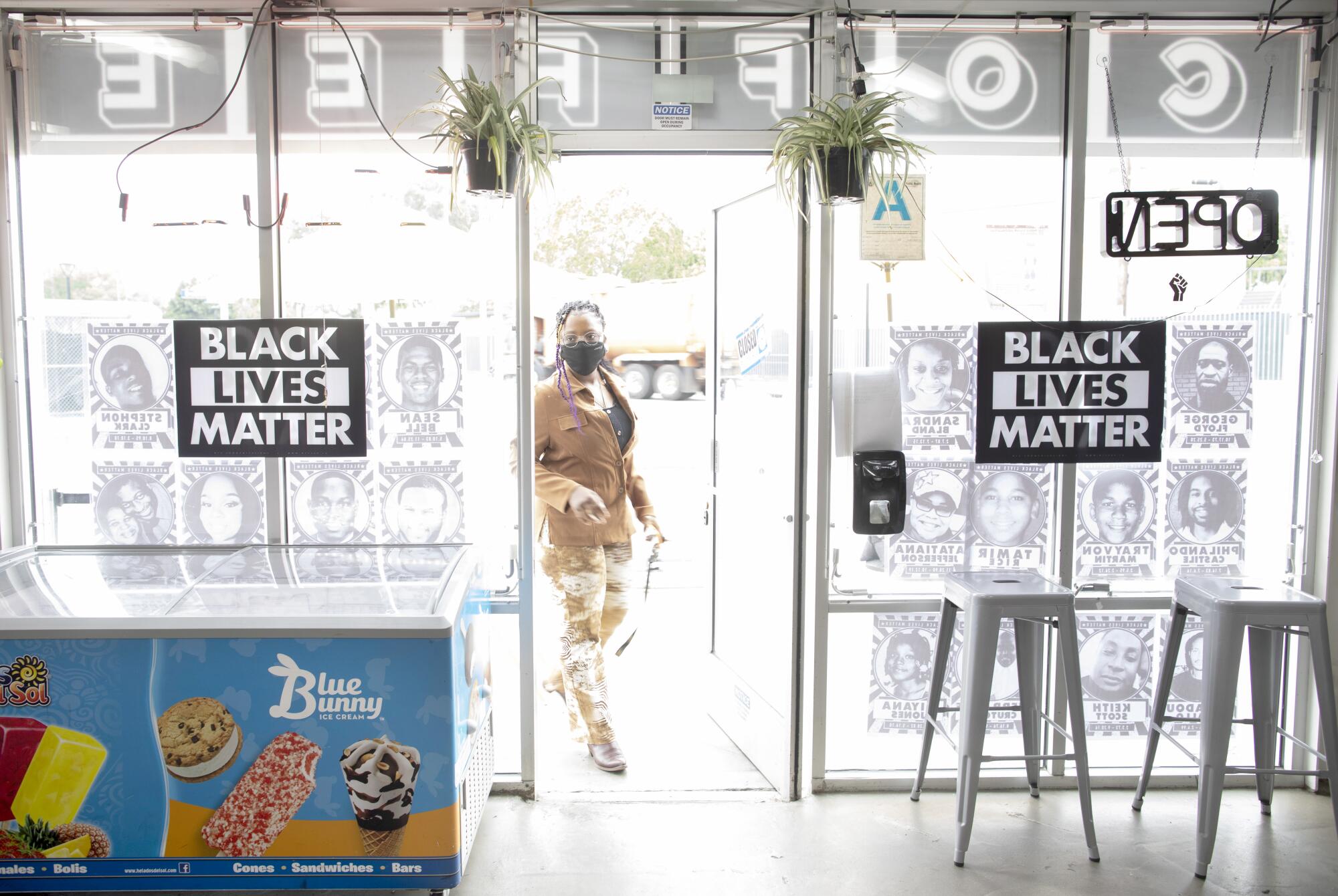
Joe and Celia Ward-Wallace opened South LA Cafe in November 2019 with that exact vision. Celia, who has a community organizing background, walked into the vacant building on the corner of Western and Browning and told her husband: “This is so much more than a coffee shop.”
She imagined it as a cultural hub, a community center, a co-working space, a grocery store in a food desert, somewhere local activists could come together and plan. And for a while, it was all those things; people seemed genuinely excited to have a coffee shop in their backyard owned by people from the neighborhood. South LA Cafe stocked beans from Red Bay Coffee, a Black-owned roaster from Oakland, and pastries from Homeboy Industries’ Homeboy Bakery. It hosted 17 events in four months after opening, including one honoring Kobe Bryant and several open mike nights. There’s a Nipsey Hussle mural on the back wall that customers often stopped to take selfies with. They also loved the crewnecks for sale that had “South Central” stamped on the front.
During the pandemic, South LA Cafe’s sales dropped 70%, forcing the company to lay off 90% of its staff. So the owners swiftly launched an online ordering app, started delivering meals to thousands of local seniors, and started a monthly membership program, through which they asked customers for $10 a month to aid in the shop’s survival. (It spurred 500 individual donors — 300 of whom continue their support.) Next, the Ward-Wallaces launched the South LA Cafe grocery box program, selling $35 boxes of fresh produce to community members who couldn’t or did not want to brave the grocery store. The program also provided an opportunity to sponsor boxes for those in need. It has since morphed into the South LA Cafe Grocery Giveaway, with the coffee shop collecting donations to offset a portion of the costs to provide food on a weekly basis for those who are food insecure.
“We’ve fed over 40,000 people in the community in less than a year,” Celia says. “We just deepened into our mission and purpose. The intention was set, the seed was set, and now it’s just bloomed through one of the most terrible times.”
Deeper than coffee
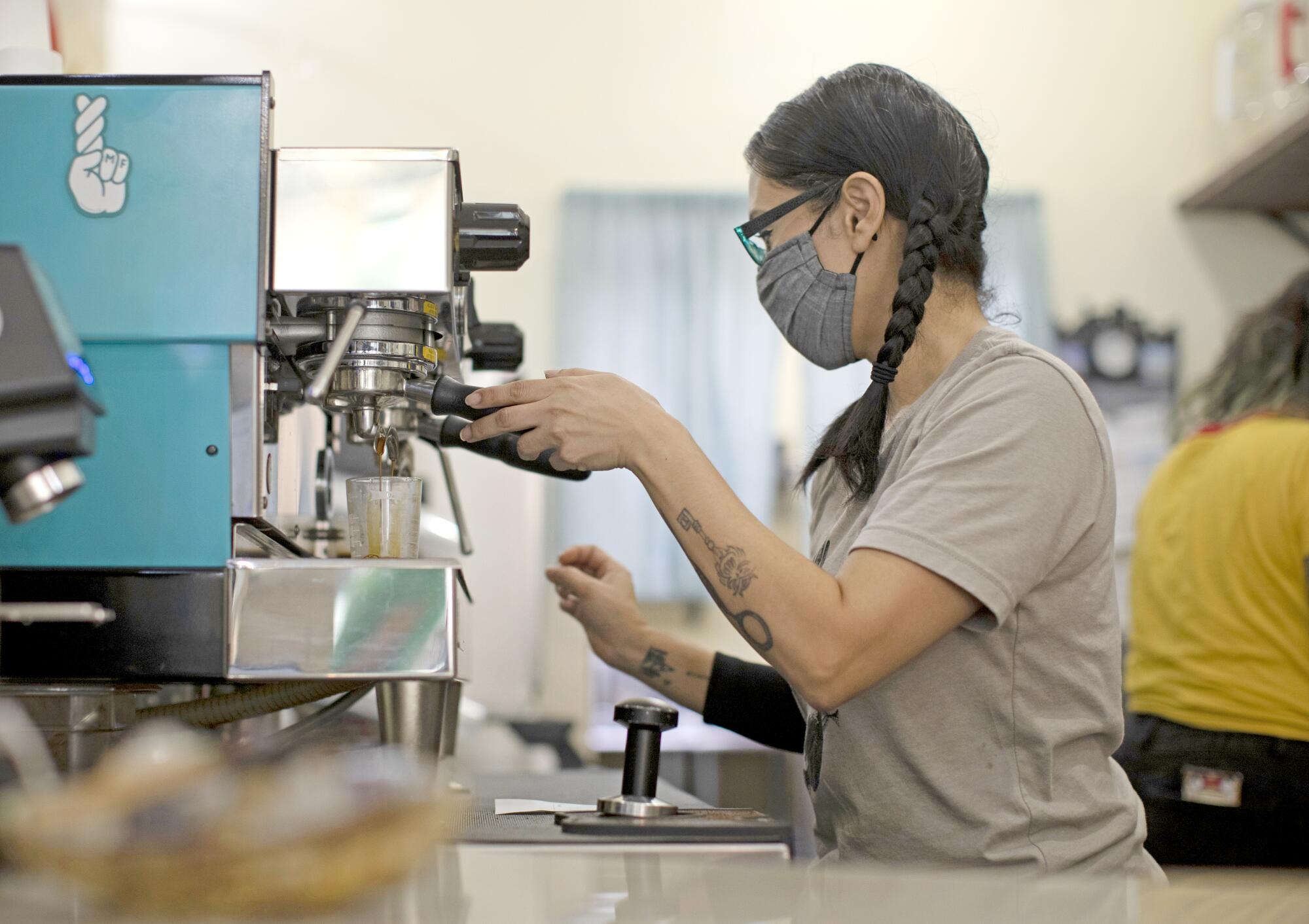
On a hot morning in Boyle Heights, Zuly Garcia, a 24-year-old art director, photographer, producer and set designer, and Hazel Valenzuela, a 27-year-old cinematographer, are at Capuyo Cafe to brainstorm and plan for an upcoming production they’re working. They have a mini generator in tow in case the shop’s move to an outdoor-only space meant there were no outlets for their laptops. The months of working from home, in an echo chamber of their own thoughts, was starting to get to them. So they sought out a neutral space with plenty of caffeine to collaborate on their ideas.
“Meeting with people to talk about the idea — you can go on a Zoom call for that, you know,” Garcia says. “But there’s something about meeting with them in person and the experience and just feeling like things are a little back to normal while grabbing that coffee.”
As they work on their production concept, Garcia and Valenzuela are feeding off the shop’s “cluster of energies,” as Valenzuela puts it. “Through the pandemic we were just stuck with our own energy, and it was such an imbalance,” she says. “Even just eye contact, or a ‘Hi, how are you?’ — that energy really does something to your own frequency.”
The main reason the friends went to Capuyo versus a different shop was because it’s Latina-owned. Valenzuela said this kind of intentionality is important to them as the world reopens and they decide where to spend their dollars.
Garcia grew up on Crenshaw and Jefferson and is hyper-aware of the complicated, even political nature of coffee shops in Black and brown communities. She’s seen them be avatars for gentrification in her own neighborhood, representative of the reason why many of her neighbors aren’t her neighbors anymore.
Capuyo co-owner Daisy Iñiguez has seen this attitude become even more common among her customers in the last year, spurred by the social justice uprisings over summer. Recently, she had a father-daughter duo drive in from Anaheim to get one of her drinks. It was their weekend tradition of patronizing Latinx-owned cafes across Southern California.
“It’s a new thing where people are being more aware and being more intentional of where they’re spending their money, because they’re realizing, ‘Wow, the big guy definitely doesn’t need my money,’” Iñiguez says.
Not all little guys are winning, however. Countless coffee shops and cafes across the city have closed in the last year. Cafe Demitasse owner Bobak Roshan announced last month that the pandemic (and his landlords’ inflexibility, he says) forced him to close his first cafe in Little Tokyo for good in May. He grieves over the space that once was. For a decade, Demitasse Little Tokyo occupied a slice of Onizuka Street in a tourist and cultural center, near the courthouses and old Times building.
“On any given day, we would have the federal public defender in there,” Roshan remembers. “We would have old Japanese grandmothers who would hobble in. You would see people in the cosplay world dressed up as Pikachu. Anytime there was a protest, that was great for business.”
Some of his customers became friends at the wraparound bar. His baristas and regulars were like family. Losing the physical space during the shutdowns and being forced to switch to takeout only was crushing, Roshan says.
“What was the point of going anymore?”
Roshan has been left slightly disillusioned about the future of coffee shops in L.A.
“The business of running a small coffee shop in Los Angeles, where you have to muscle with the big-money Blue Bottles and Intelligentsias, not to mention having three Starbucks open doors in your neighborhood … it’s tough. I’m not sure it’s worth the grind.”
Reimagining the future
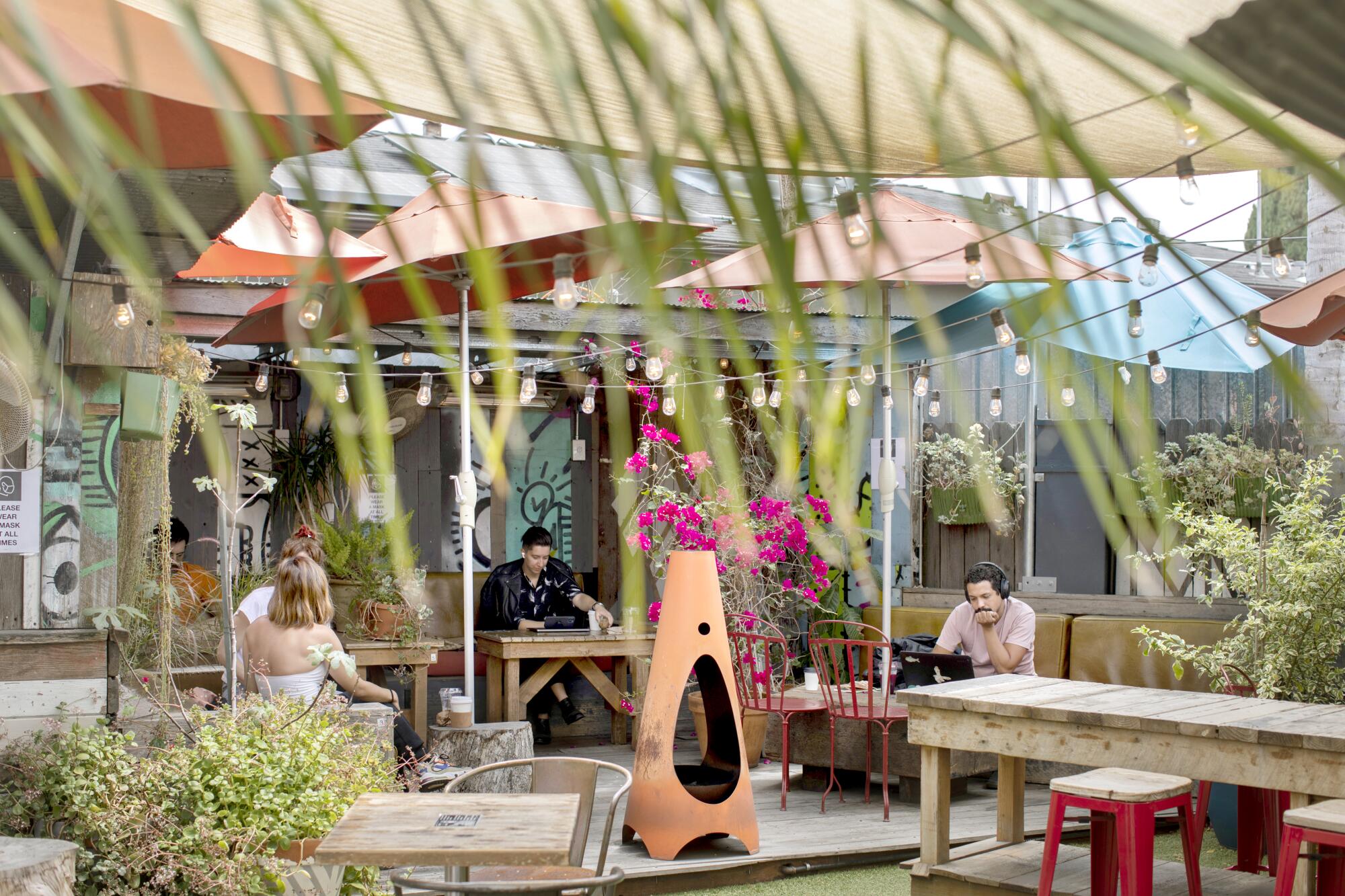
There are some owners, like Cafecito Organico’s Angel Orozco, who are using the reopening to reimagine their shop’s culture — and try to broaden it.
Pre-pandemic, the seating area at Cafecito Organico Silver Lake was the kind of place you’d go to eavesdrop on people talking about the script they were allegedly working on. “It was a lot of up-and-coming people in the industry, all these kids from the Midwest,” says Orozco, who was born in Guatemala and raised in L.A. The area was once made up mostly of working-class Latino families, who in the last few decades have been pushed out.
Now there are a lot of transplants — young actors, writers and creatives. Hoover Wilderness, the shop’s lush backyard-like space with overgrown succulents and bougainvillea bushes, has become a magnet for them.
On a recent Saturday afternoon, it was packed but silent. Most people were staring at a laptop or engrossed in a book. Some were staring off into space with AirPods on. There were signs on each table reminding people to keep their masks on and respect guidelines. Three friends who work in the video and music industry were settling a drunken spat from the night before over cold brew and lattes. Walking up to a stranger still felt illicit.
What was it about coffee shops in L.A., anyway? They are staples in almost every city in the world — each place with its own distinct culture surrounding them — but our relationship to them felt singular.
In L.A., when we had time, we ordered our coffee to stay. We became fiercely loyal to the places we went. We soaked up the human energy at coffee shops that wasn’t available in the streets. We felt seen when the barista started to recognize us and our order. We trekked an extra 20 minutes for ambiance alone. Where you drank your coffee was a coded language for what role you played in this city and what priorities you had.
The rules were different than a restaurant, different than a bar. It was a context for both business and pleasure.
Coffee shop culture in this city had range, and the role it can play as we hurl toward reopening, in reigniting connection alone, feels unique.
In this new era, Orozco is hoping to change the way people experience this space and also hopefully regain control over the seating, which he says customers have taken over in recent years: “Pre-pandemic, I would see people there in the morning and I would come back in the afternoon, they were still there,” he says.
But mostly, he knows that as we emerge from dormancy, his coffee shop has to offer more than just its signature espresso. Orozco plans to add a taqueria and is experimenting with the idea of playing music in the back.
“It’s this idea of being more of a resource,” he says. “At least for coffee shops, we have to re-imagine our spaces a little more.”
More to Read
Sign up for The Wild
We’ll help you find the best places to hike, bike and run, as well as the perfect silent spots for meditation and yoga.
You may occasionally receive promotional content from the Los Angeles Times.
